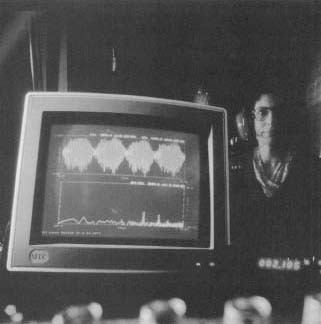Audiometer
An audiometer is an instrument used to measure how well a person hears. The ear is a complex organ. It receives sound in the form of vibrations that strike the eardrum. These vibrations move from the eardrum through the bones of the middle ear to the cochlea (a spiral-shaped organ filled with fluid). The vibration sets the fluid in motion and sensory cells along the cochlea's basilar (at the bottom or base of) membrane (a thin covering through which things can pass) send messages of the sound to the brain.
The brain distinguishes many distinct sounds. Pitch

The Audiometer Test
An audiometer consists of four parts. These parts are the oscillator (used to change the frequency of sounds heard), an audio amplifier, an attenuator (used to control volume loudness), and a pair of headphones. The person being tested wears the headphones. The amplitude of a tone is slowly increased until the person hears the sound. The lowest decibel level at which a sound is heard is called the threshold. The oscillator is used to change pitch so a range of sounds can be tested. When manufacturing audiometers and performing audiometer testing, care is taken to eliminate background noise.
The result of a hearing test using an audiometer is called an audiogram. The audiogram is a graph that shows the lowest decibel level at which each frequency is heard. The graph gives a profile of the person's threshold of hearing. It compares the profile to a line representing normal hearing in order to detect hearing loss. Using the audiometer, frequency is varied from 64 hertz to over 8,000 hertz. Amplitude can be varied in five decibel increments. In addition to pure tones, speech sounds are sometimes used as test signals. Hearing is considered good if every tone sounded between 64 and 8,192 hertz is heard at a volume of 20 decibels. Hearing loss is generally greatest at the high frequencies. This seems to occur in many people over fifty.
Békésy's Invention
The pure-tone audiometer was invented by Georg von Békésy (1899-1972; winner of the Nobel Prize), a Hungarian-American physicist. His machine was a patient-operated instrument released in 1946. Békésy studied the transmission of sound for a Hungarian telephone company. The testing the telephone lines was routinely carried out and often done with pure tones (tones of one frequency). Bekesy listened to everything he heard over the telephone lines—he even listened to the clicks when phones were being connected and disconnected! He started using the clicks as test signals. The clicks themselves were a combination of many pure tones that came along the telephone lines in a single short pulse. Bekesy's early experiences helped him study hearing in great detail and arrive at his audiometer design.
but i want to know the parts and working of audiometer